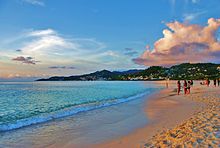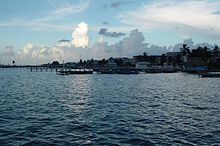- Shore
-
This article is about land next to a body of water. For other uses of shore, see Shore (disambiguation). For other uses of shoreline, see Shoreline (disambiguation)."Ashore" redirects here. For the June Tabor album, see Ashore (album).
 Shore of Grand Anse Beach, St. George's, Grenada, West Indies
Shore of Grand Anse Beach, St. George's, Grenada, West Indies
A shore or shoreline is the fringe of land at the edge of a large body of water, such as an ocean, sea, or lake. In Physical Oceanography a shore is the wider fringe that is geologically modified by the action of the body of water past and present, while the beach is at the edge of the shore, representing the intertidal zone where there is one.[1] In contrast to a coast, a shore can border any body of water, while the coast must border an ocean; that is, a coast is a type of shore. Shore is often substituted for coast where an oceanic shore is meant.Shores are influenced by the topography of the surrounding landscape, as well as by water induced erosion, such as waves. The geological composition of rock and soil dictates the type of shore which is created.
See also
- Ballantine Scale
- Beach
- Beach evolution
- Coast
- Littoral zone
- Marine Sciences Research Center
- Strand plain
References
- ^ Pickard, George L.; William J. Emery (1990). Descriptive Physical Oceanography (5, illustrated ed.). Elsevier. pp. 7–8. ISBN 075062759X, 0750627597.
External links
- "shore". The American Heritage Dictionary of the English Language (4 ed.). 2000. http://www.bartleby.com/61/7/S0360700.html.
- "shore". Merriam-Webster Online. 2009. http://www.merriam-webster.com/dictionary/shore.
Categories:- Topography stubs
- Landforms
- Coastal geography
Wikimedia Foundation. 2010.


